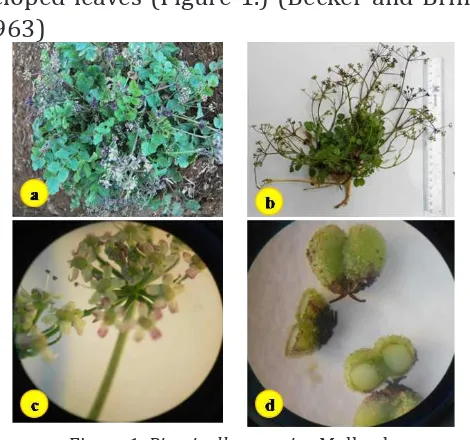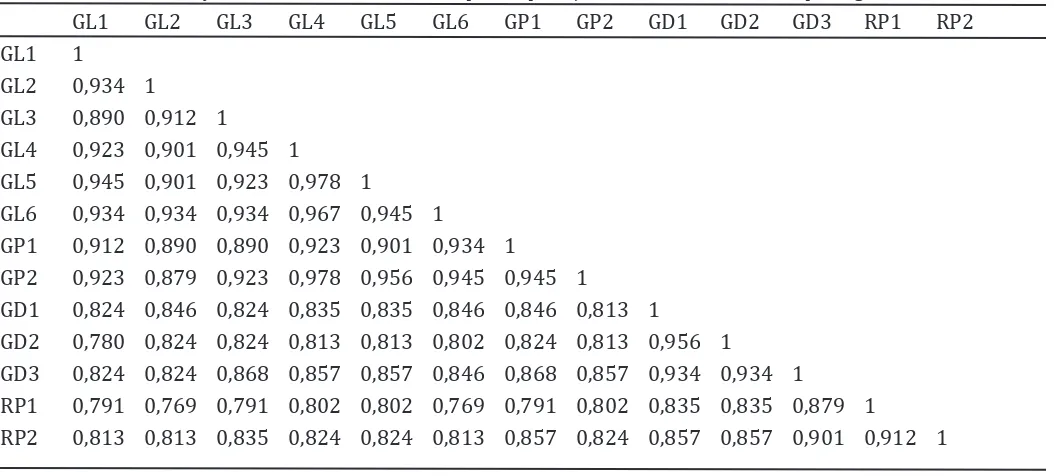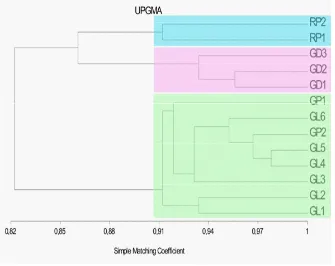Berdasarkan Karakter Morfologi
Harto Widodo*, Azizatur Rahmah**, Rina Sri Kasiamdari**
*Medicinal Plant and Traditional Medicine Research and Development Centre **Biology Faculty Post Graduate of GadjahMada University
e-mail: [email protected]
ABSTRAK
Purwoceng (Pimpinella pruatjan Molkenb.) merupakan tanaman Indonesia yang memiliki khasiat sebagai afrodi -siak, diuretik dan tonik. Menurut beberapa literatur, tanaman purwoceng tumbuh hanya di daerah dataran tinggi, mulai 1.800 sampai 3.500 meter dpl di pegunungan tertentu di Pulau Jawa, yaitu Gunung Semeru, dataran tinggi Di-eng, dan gunung Pangrango. Saat ini sulit untuk menemukan purwoceng di alam liar, bahkan di gunung Pangrango dilaporkan spesies ini telah punah. Tanaman ini terdaftar sebagai spesies yang terancam punah dan hampir punah (Lampiran I) oleh Konvensi Perdagangan Internasional Spesies Langka Liar Flora dan Fauna (CITES). Setidaknya terdapat enam aksesi purwoceng yang telah dibudidayakan di Gunung Lawu telah ditemukan yang berbeda dari tetuanya dari Dataran Tinggi Dieng. Mengingat potensi yang sangat tinggi sekaligus untuk konservasi tanaman, penelitian pendahuluan dilakukan untuk mempelajari hubungan purwoceng yang dikumpulkan dari empat tempat tumbuh pada fitur morfologi. Total terdapat 91 karakter yang diperiksa dari 13 aksesi yaitu dua aksesi diperoleh dari Ranupani BTSNP Semeru (RP1 dan RP2); enam aksesi dari Gunung Lawu (GL1, GL2, GL3, GL3, GL4, GL5 dan GL6); tiga aksesi dari Dataran Tinggi Dieng (GD1, GD2 dan GD3); dan dua aksesi dari Gunung Putri (GP1 dan GP2). Data dianalisis dengan menggunakan MVSP 3.1 software dan algoritma UPGMA dipergunakan untuk menghasilkan dendogram. Hasil penelitian menunjukkan bahwa semua aksesi memiliki koefisien sederhana pencocokan (SSM)> 82%. Mereka membentuk tiga kelompok dengan SSM> 91%, kelompok pertama terdiri dari semua aksesi dari Gu -nung Lawu dan aksesi dari Gu-nung Putri, kelompok kedua terdiri dari aksesi dari Dataran Tinggi Dieng, sedangkan aksesi dari RanuPani TBSNP-Gunung Semeru dikelompokkan ke dalam kelompok ketiga.
Kata kunci: Pimpinella pruatjan Molkenb, morfologi, aksesi.
ABSTRACT
Purwoceng (Pimpinella pruatjan Molkenb.) is an Indonesian plant which has medicinal properties for
aphrodisi-ac, diuretic and tonic. This plant grows only in high attitude area between 1,800 to 3,500 meters above sea level at the certain mountains of Java Island, i.e. Mount Semeru, Dieng plateau, and mount Pangrango. Nowadays it is hard to find P. pruatjan grows wildly, due to its high extinction. Convention on International Trading in Endangered Species of Wild Flora and Fauna (CITES) categorized purwoceng as endangered and nearly extinct (appendix 1). At least six accessions of cultivated P. pruatjan in Mount Lawu were found which are different from their ances
-tor from Dieng Plateau. Considering the high potential and conservation concern of the plant, the preliminary research was conducted to study the relationship of P. pruatjan collected from four reported growth locations based on morphological features. Ninety one of characters were examined for 13 accessions i.e. two accessions from Ranu Pani BTSNP-mount Semeru (RP1 and RP2); six accessions from Mount Lawu (GL1, GL2, GL3, GL3, GL4, GL5 and GL6); three accessions from Dieng Plateau (GD1, GD2 and GD3); and two accessions from Mount Putri (GP1 and GP2). The data were analyzed using MVSP 3.1 software and UPGMA algorithm was utilized to generate dendogram. The result showed that all accession have simple matching coefficient (SSM) >82%.
They formed three groups with SSM>91%, the first group consisted of all accessions from Mount Lawu and acces
-sions from Mount Putri, the second group consisted of acces-sions from Dieng Plateau, whereas acces-sions from RanuPaniTBSNP-Mount Semeru clustered into the third group.
Keywords: Pimpinella pruatjan Molkenb., morphology, accession
INTRODUCTION
Indonesia is well known as one of mega biodiversity countries in the world. It is
esti-mated that the amount of Indonesia flowering plant species is about 35,000 (55% endemic).
One of Indonesian endemic plants possessing
therapeutic importance is Purwoceng ( Pimp-inella pruatjan Molkenb.). Its root is empiri-cally used as aphrodisiac, diuretic, and tonic
(Caropeboka, 1980). P. pruatjan has been used
to increase stamina; it also has properties as
analgesic, antipyretic, anthelmintic, antibiotic,
and anticancer (Rahardjo, 2005).
Pimpinella pruatjan Molkenb. belongs to Apiaceae family, with the following mor-phologycal traits, the leaves in one or more radical rosette, petioled, hairy on both
sur-faces, imparipinnate; leaflets 3-11, sessile or
subsessile, cordate-orbicular, crenate-dentate,
1-2.5 cm long. It has umbellules 4-8 flowers,
and the stem is striate. The plant has strong aroma, with a thick root and numerous
ascend-ing flowerascend-ing stems bearascend-ing only poorly de
-veloped leaves (Figure 1.) (Becker and Brink, 1963)
Figure 1. Pimpinella pruatjan Molkenb. Legend: a. b. Habitus; c. Flower; d. Fruit and seed
P. pruatjan is an Indonesian indigenous plant which is growing endemically in mountainous
area, such as Dieng Plateau in Central Java, Pangrango and Galunggung Mountain in West
Java, as well as Tengger and Iyang Highland
in East Java (Heyne, 1987). Nowadays, the
population of P. pruatjan drecrease dramatically due to a large scale of genetic erosion, even the
population in West Java and Mount Pangrango
mountainous area in East Java was reported
to have perished (Darwati and Rostika, 2006). Research on endangered medicinal plant in Bromo Tengger Semeru National Park (BTSNP)
indicated that P. pruatjan has been classified
as Critically endangered even categorized as
Extinct in the wild (Hidayat and Risna, 2007).
P. pruatjan can be found at high area
with the altitude of 1.800-3.300 meters above
sea level (m asl), and it grow well thrives
approximately 2.000 m asl. (Rahardjo, 2005). Cultivating in area lower than 1.700 m asl will decrease productivity of the plant both quantity and quality. Purwoceng has low altitudinal adaptability (Wahyuni, 2009). Cultivating trial in areas with altitude of 600-800 m asl showed
that the plant was only able to survive for three
months (Darwati and Rostika, 2006).
Previous study on morphological and
genetic variations of P. pruatjan disclosed that there are two types of P. pruatjan which have
slight differences between them. The first types has green petiole and white flower and
the other has purple color both its petiole and
flower. Analysis using Inter-Simple Sequence Repeat (ISSR) primers revealed that those two
types had genetic variations (Widodo et al.,
2012). Further elaborative investigation of the
Mount Lawu using the basis phenotypic features founded more than two morphological types of
P. pruatjan. This morphological diversity of the species might indicate the form of its genetic and environmental interactions.
Plant morphological characters were obviously influenced by environmental factors (Pujiasmanto et al., 2007; Stenstrom et al., 2007). These factors include altitude,
precipitation, light intensity, soil pH, soil temperature, and soil nutrients. Environmental
factors such as different altitude basically affect
in anatomy and morphology characteristics. Study on Festuca sp. Demonstrated that heat-tolerant cultivars had larger cells and more sclerenchyma and collenchyma (supporting tissue) in between the vascular bundle and epidermal cells compared with heat-sensitive
Festuca cultivars (Zhang et al., 2005). To be
able to grow well each species of plants has its own optimum temperature, thus its natural growth distribution depends on temperature zone.
Morphological characters or external features currently provide most of characters
used for practical plant identification and
many of those are used for hypothesizing phylogenetic relationships (Judd et al., 1999).
The morphological character recognition is still used as the basis of preparation of
plant classification. Classification based on
morphological characters can be used as a general reference for precise and rapid preparation of plant diversity maps, especially for Angiosperm. Morphology can be observed with a more convenient and practical compared with other properties (Jones and Luchsinger,
1986).
Simplicia of P. pruatjan is major ingredient for aphrodisiac Jamu formula used at Saintifikasi Jamu Program. This program was launched by issueing Ministry of Health
Republic of Indonesia (MHRI) Decree Number 003/Menkes/Per/I/2010 to provide evident
based data about the safety,
quality and efficacious of Indonesia herbal
medicine (JAMU) through service based
research. Raw materials of medicinal plants
used in that program should be standardized thus medicinal plant, as a row material of Jamu, should be standardized as well. Authentication species of medicinal plants is one of the crucial
first steps to obtain standardized medicinal
plants.
Based on the above mentioned background discussion, this preliminary research aims to provide data on P. pruatjan
diversity and to determine the relationship
of the accessions collected from four different
growth locations on the basis of morphological features. Mount Putri (West Java) and Ranu Pani BTSNP–
Mount Semeru (East Java). This research was
conducted from March to December 2012. The map (Figure 2.) figured out the regions in
which the study was conducted.
Methods
P. pruatjan collected from each region both from wild habitat and cultivated area were grouped according to their major
resemble characters (i.e. leaf, petiole, flower).
This traits were distinguishable without any measurement tool. This preliminary groups
were determine as accessions. Vegetative
part (root, stem, leaf) and reproductive parts
(fruits, flowers, and seeds) were observed
to determine morphological features of each accession. Ninety one characters were
identified. Voucher herbarium of specimens
were collected in all accessions and placed
in Medicinal Plant and Traditional Medicine Research and Development Centre (MPTMRDC)
Herbarium.
Figure 2.The locations of Pimpinella pruatjan Molk. Colection site
Legend:
A. Mount Putri West Java Province with the altitude of 1,623 m. a.s.l.
B. Dieng PlateauCentral Java Province with the altitude of 2,039 m. a.s.l.
C. Mount Lawu Central Java Province with the altitude of 1,800 m. a.s.l.
D. Ranu Pani BTSNP-Mount Semeru East Java Province with the altitude of 2161 m. a.s.l.
Data Analysis
Morphological dataset representing
each observed characters were encoded 0,1,2,3
and so on, then analyzed by using the Multi
Variate Statistical Package (MVSP) Version 3.1 with the Simple Matching Coefficient (SSM).
Index similarities of many type comparable operational taxonomic units (OTU`s) were analyzed and clustered to generate dendrogram
using UPGMA algorithm.
RESULTS AND DISCUSION
Accession or ecotype is the smallest unit
in the population which has a specific genetic
character. Morphological characters consist
of the differences and similarities between
plants that occur in general. Its value can be measured from the stability, the more stable
character, the better the level of confidence or otherwise (Lawrence, 1955).
Based on major morphological resemble characters, i.e.: leaf shape, the color of petiole,
13 accessions of P. pruatjan from four observed locations were characterized. The highest diversity found was P. pruatjan from Mount Lawu that had six accessions where as from
Mount Putri, Dieng Plateau and Ranu Pani BTSNP-Mount Semeru were two, three, and two accessions, respectively (Table 1.)
Table 1. Determining accession based on major morphological characters
No Location Type of location Number Accession
of accession code
characterized
1. Mount Lawu Cultivating garden 6 GL1, GL2, GL3, GL4, GL5 and GL6
2. Mount Putri Cultivating garden 2 GP1 and GP2
3. Dieng Plateau Cultivating garden 3 GD1, GD2 and GD3
4. Ranu Pani Natural habitat 2 RP1and RP2
BTSNP- Mount
P. pruatjan from Mount Lawu was more diverse. This may occur due to environmental stress. It was mentioned that P. pruatjan was progeny of P. pruatjan from Dieng Plateau
which have been cultivated in Mount Lawu at
MPTMRCD research garden since 2007. At the
beginning of cultivating trial of P. pruatjan in
research area (1.200 m asl.) onlya few plants
were able to survive. Those might have been able to adapt to the less optimum environment for their growth through a variety of mechanisms
for survival. As mentioned by Vince and Zoltán (2011), plants have various mechanisms that
allow them to survive and often prosper in the complex environments in which they live. The mechanisms may either through genetic changes or just phenotypic plasticity which provide morphological variations.
These phenotypic variations might be due to responds of the plants to the environment
in which they grow. Parthasarathy (2010)
reported that environment factors were having
a high degree influence on morphological as
well as biochemical characters of the species.
Grazing and competition can also change plant morphology to a great extent (Pollard, 1986).
Table 2. Similarity index of 13 accessions of Pimpinella pruatjan Molkenb. based on morphological characters
GL1 GL2 GL3 GL4 GL5 GL6 GP1 GP2 GD1 GD2 GD3 RP1 RP2
GL1 1
GL2 0,934 1
GL3 0,890 0,912 1
GL4 0,923 0,901 0,945 1
GL5 0,945 0,901 0,923 0,978 1
GL6 0,934 0,934 0,934 0,967 0,945 1
GP1 0,912 0,890 0,890 0,923 0,901 0,934 1
GP2 0,923 0,879 0,923 0,978 0,956 0,945 0,945 1 GD1 0,824 0,846 0,824 0,835 0,835 0,846 0,846 0,813 1 GD2 0,780 0,824 0,824 0,813 0,813 0,802 0,824 0,813 0,956 1 GD3 0,824 0,824 0,868 0,857 0,857 0,846 0,868 0,857 0,934 0,934 1 RP1 0,791 0,769 0,791 0,802 0,802 0,769 0,791 0,802 0,835 0,835 0,879 1 RP2 0,813 0,813 0,835 0,824 0,824 0,813 0,857 0,824 0,857 0,857 0,901 0,912 1
These environmental factors can interact.
Furthermore, Douglas (1981) showed that
competition reduced the size of Mimulus
primuloides plants at low altitudes, while low temperatures reduced size at higher altitudes
and consequently the largest plants were found
at intermediate altitudes.
In this study, the characters were determined from vegetative and generative morphological characters. The characters were
composed of the roots, leaves, stems, flowers
and fruit. Thirteen accessions of P. pruatjan were observed in term of morphological characters
covering 91 characters, 41 characters of them
were polymorphic.
The accessions collected from Mount
Putri (GP), Dieng Plateau (GD), Mount Lawu (GL) and Ranu Pani (RP) have highly morphological similarity. RP1 had a distinct
characters compared to other accessions. It
had the lowest similarity index of 76,9% to both GL2 and GL6. Based on the taxon-species
concept that single individualis was considered as members of one species if it showed a
similarity index of ≥70%. It was confirmable
that those all accessions are still in the same species.
Clustering analysis using UPGMA (Unweighted Pair Group Method Using
Arithmetic Mean) algorithm revealed the
relationship among 13 accessions of P. pruatjan
based on morphological characters (Figure 3.).
Clustering dendrogram with Simple Matching Coefficient (SSM)>91%(Table 2.), showed three groups of the accessions. Group 1 consisted of RP1 and RP2 accessions with
SSM 91,2%, originating from Ranu Pani BTSNP-Mount Semeru. These accessions demontrated which had slightly distinctive morphological character to the accessions from other
locations. Group 2 comprised of GD1, GD2 and GD3 with SSM 93,4%, accessions from Dieng Plateau. And group 3 clustered among GL1, GL2, GL3, GL4, GL5 GL6, GP1 and GP2, with SSM 91,2%.
Those three groups were formed by the values of closeness between each accession. Similarity index in Table 2. were generated
from 91 morphological characters. Accessions
showed similarities to join the same group
as group 1 and group 2. Group 3 was a combination of GL and GP accessions. Although
the geographic distance between Mount Lawu
and Mount Putri was far away, GL and GP accessions were the same ancestor. Both GL and GP accessions were from Dieng Plateau.
They have the same characters that might be joined to the same group. Ex-situ cultivation at lower altitude than the original habitat resulted in changing of the morphological characters of
the offspring.
Dendrogram generated from UPGMA
analysis showed that accessions from the same place joined to the same group though they
had different similarity values. In conclusion,
accessions from the same place joined to the same group. Due to adaptation to the new
different environments, the offspring of P.
pruatjan would change their morphological
characters different from their ancestors. The
validity of the results obtained from this study
is considerably affected by the sensitivity
of these traits to environmental factors and physiological stages of plants. Thus other approaches methods to reveal the relationship of the P. pruatjan accessions is needed.
REFERENCES
Becker DSC.and Van De Brink RCB.1963. Flora of Java (Spermatophytes Only). N.V.P.
Noordhoff -Groningen-The Netherlands. p:176
Caropeboka AM. 1980. Pengaruh ekstrak akar
Pimpinella alpina Koord. Terhadap
sistem reproduksi tikus. Tesis. Institut
Pertanian Bogor. Bogor. p 73 Darwati I. dan Roostika I. 2006. Status
penelitian purwoceng di Indonesia.
Buletin Plasma Nutfah, 12(1):9-15.
Douglas DA.1981. The balance between
vegetative and sexual reproduction of
Mimulus primuloides (Scropholariaceae)
at different altitudes in California. Journal of Ecology, 69: 295-310.
Heyne K. 1987. Tumbuhan berguna Indonesia.
Jilid III. Balai Penelitian dan Pengembangan Kehutanan. Jakarta. Hidayat S. and Risna R. 2007. Kajian Ekologi
Tumbuhan Obat Langka di Taman Nasional Bromo Tengger Semeru.
Biodiversitas, 8(3): 169-173
Jones SBJr. & Luchsinger A. 1986. Plant
Systematics. McGraw-Hill Book
Company. New York. P 587.
Judd WS., Campbell CS., Kellogg EA., Stevens PF. 1999. Plant Systematic, A Phylogenetic
Approach. Sinauer Associates, Inc.
Massachusetts U.S.A. 464p.
Lawrence GHM.1955. An Introduction to Plant
Taxonomy. The Macmillan Company. New York. p:15-17.
Parthasarathy U. 2010. Intra Species Diversity Influenced By Environment. Proceeding
of the National Seminar on Soil, Water,
and Crop Management for Higher Productivity of Species. India. p:136-146.
Pollard AJ. 1986. Variation in Cnidoscolus texanus in relation to herbivory.
Oecologia, 70: 411-413.
Pujiasmanto B., Moenandir J., Syamsulbahri & Kuswanto. 2007. Kajian Argoekologi
dan Morfologi Sambiloto (Andrographis paniculata Ness.) pada Berbagai Habitat.
Biodiversitas, 8(4):326-329.
Rahardjo M. 2005. Purwoceng Budidaya dan Pemanfaatan untuk Obat Perkasa Pria.
Cetakan I, Penebar Swadaya, Depok. Pp:59.
Stenstorm A., Jonsdottir IS. and Augner M.
2002. Genetic and Environmental Effects on Morphology in Clonal Sedges
in the Eurasian Arctic. American Journal
of Botany, 89(9):1410-1421.
Vince Ö. and Zoltán M. 2011. Plant Physiology, Plant stress physiology. Pannon Egyetem
h t t p : / / w w w. t a n ko ny v t a r. h u / e n /
tartalom/tamop425/0010_1A_Book_
angol_ 01_novenyelettan/ch04s05.
html. Accessed: 28-May-2014
Wahyuni S. 2009. Evaluasi karakter morfologi
purwoceng (Pimpinella pruatjan Molk.)
generasi M1 hasil induksi mutasi sinar gamma di Cicurug dan Cibadak. Makalah
Seminar Departemen Agronomi dan Hortikultura Fakultas Pertanian Institut Pertanian Bogor.
Widodo H., Widayat T., Subositi D. 2011.
Standarisasi Tanaman Purwoceng
(Pimpinella pruatjan Molk.) sebagai Bahan Baku Obat Afrodisiaka, Sub
Judul: Karakterisasi Genetik dan Kajian Teknik Budidaya Tanaman Purwoceng
(Pimpinella pruatjan Molk.). Laporan Akhir Penelitian. Balai Besar Penelitian
Dan Pengembangan Tanaman Obat Dan
Obat Tradisional. (Unpublished)
Zhang Y., Mian MAR, Chekhovskiy K., So S., Kupfer D., Lai H. & Roe BA. 2005. Differential gene expression in Festuca
under heat stress conditions. J Exp. Bot.,
56(413): 897-907.
Zhao K., Zhou MQ. & Chen LQ. 2007. Genetic
diversity and discrimination of
Chimonanthus praecox L. Link



